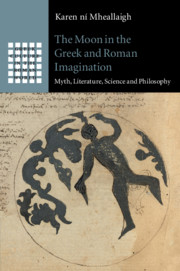Book contents
- The Moon in the Greek and Roman Imagination
- Greek Culture in the Roman World
- The Moon in the Greek and Roman Imagination
- Copyright page
- Dedication
- Contents
- Acknowledgements
- Abbreviations, Text References and Translations
- Part I The Moon in the Mythic Imagination
- Part II The Moon in the Scientific Imagination
- Chapter 2 Making Sense of the Moon
- Chapter 3 Life on the Moon
- Chapter 4 The Moon of Many Faces
- Part III The Moon in the Fantastic Imagination
- Bibliography
- Index
- Index Locorum
Chapter 3 - Life on the Moon
Between Philosophy, Science and Fantasy
from Part II - The Moon in the Scientific Imagination
Published online by Cambridge University Press: 09 October 2020
- The Moon in the Greek and Roman Imagination
- Greek Culture in the Roman World
- The Moon in the Greek and Roman Imagination
- Copyright page
- Dedication
- Contents
- Acknowledgements
- Abbreviations, Text References and Translations
- Part I The Moon in the Mythic Imagination
- Part II The Moon in the Scientific Imagination
- Chapter 2 Making Sense of the Moon
- Chapter 3 Life on the Moon
- Chapter 4 The Moon of Many Faces
- Part III The Moon in the Fantastic Imagination
- Bibliography
- Index
- Index Locorum
Summary
In several senses, Anaxagoras is one of the great landmark figures in the history of the Moon. In the previous chapter we saw how, in Parmenides’ wake, he brought to fruition a great paradigm-shift from ‘meteorological’ to ‘lithic’ astronomy (to use Graham’s terms). By doing so, he made the Moon habitable by postulating, for the first time, that it was an Earth-like world, radically different from the alien nebulous or fiery objects envisaged by his predecessors. Not only was it solid like the Earth, but it shared familiar features with the terrestrial landscape, such as mountains, gorges and caves – a theory that was shared by the atomist philosopher Democritus as well. It is probably no coincidence, therefore, that Anaxagoras is our earliest reported source for speculation about lunar life; he may well have been the first to grapple seriously with the idea. We are told that he envisaged ‘dwellings’ (oikēseis) and possibly even cities on the Moon, which presupposed habitation by lunar beings, and he may have claimed that the Nemean lion of myth originated there.
- Type
- Chapter
- Information
- The Moon in the Greek and Roman ImaginationMyth, Literature, Science and Philosophy, pp. 112 - 145Publisher: Cambridge University PressPrint publication year: 2020

